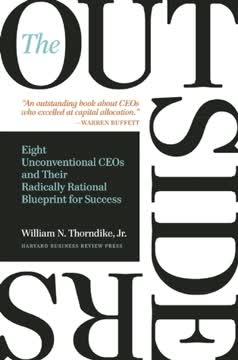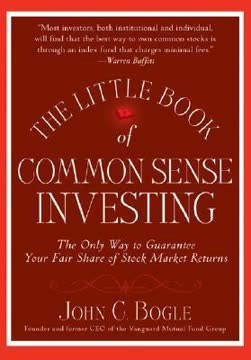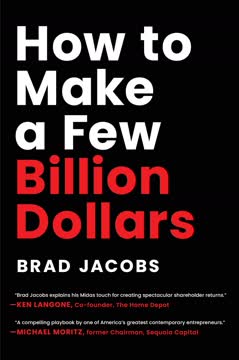Key Takeaways
1. Economic moats create sustainable competitive advantages
Companies with moats are more valuable than companies without moats.
Moats protect profits. Economic moats are structural characteristics that allow companies to maintain above-average profits for extended periods. They act as barriers, keeping competitors at bay and preserving a company's competitive edge. Moats increase a company's value by ensuring its ability to generate high returns on capital over time.
Types of moats:
- Intangible assets (brands, patents, licenses)
- High switching costs for customers
- Network effects
- Cost advantages (scale, location, unique assets)
Companies with strong moats, like Coca-Cola, Microsoft, and Johnson & Johnson, have consistently outperformed their peers and created significant shareholder value over decades. Identifying businesses with durable competitive advantages is crucial for long-term investing success.
2. Intangible assets can be powerful sources of moats
A brand creates an economic moat only if it increases the consumer's willingness to pay or increases customer captivity.
Not all brands are moats. Intangible assets like brands, patents, and regulatory licenses can create significant competitive advantages, but their value must be carefully assessed. A strong brand only constitutes a moat if it allows a company to charge premium prices or retain customers more effectively than competitors.
Examples of powerful intangible asset moats:
- Tiffany & Co.: Commands premium prices for diamonds due to brand prestige
- USG Corporation: Charges 10-15% more for its "Sheetrock" branded drywall
- Moody's Investors Service: Regulatory designation creates near-monopoly in bond ratings
Patents can provide temporary moats but are vulnerable to legal challenges and expiration. Regulatory licenses, like those in the pharmaceutical industry, can create lasting advantages by limiting competition while allowing pricing freedom.
3. High switching costs protect companies from competition
Switching costs are a valuable competitive advantage because a company can extract more money out of its customers if those customers are unlikely to move to a competitor.
Sticky customers are profitable. Companies benefit from high switching costs when customers find it difficult or expensive to change to a competing product or service. This allows businesses to maintain higher prices and profit margins, as customers are less likely to leave even if alternatives exist.
Examples of high switching cost moats:
- Banks: Hassle of changing accounts and services
- Enterprise software (Oracle, SAP): High integration and retraining costs
- Industrial suppliers (Precision Castparts): Long-term relationships and custom components
Switching costs are particularly powerful in business-to-business markets, where changing vendors can disrupt operations and require significant retraining or reconfiguration. Companies that can create high switching costs often enjoy steady, predictable revenue streams and strong customer retention.
4. Network effects create natural monopolies
Of networks, there will be few.
More users increase value. Network effects occur when the value of a product or service increases as more people use it. This creates a powerful competitive advantage, as the leading company in a market tends to attract even more users, creating a virtuous cycle that's difficult for competitors to break.
Characteristics of network effect moats:
- Natural tendency towards monopoly or oligopoly
- Exponential value growth with each new user
- High barriers to entry for new competitors
Classic examples of network effects include social media platforms (Facebook), online marketplaces (eBay), and payment networks (Visa, Mastercard). These businesses often exhibit "winner-take-all" dynamics, where the market leader captures a disproportionate share of value. Network effects are particularly potent in digital and information-based businesses, where the marginal cost of serving additional users is low.
5. Cost advantages stem from processes, locations, and scale
Being more efficient than your peers is a fine strategy, but it's not a sustainable competitive advantage unless it is based on some proprietary process that can't be easily copied.
Lowest cost wins. Cost advantages can create durable competitive moats, but only if they are difficult for competitors to replicate. Sustainable cost advantages typically come from three sources: unique processes, advantageous locations, or economies of scale.
Types of cost advantages:
- Process-based: Innovative manufacturing or distribution methods
- Location-based: Proximity to resources or customers
- Scale-based: Spreading fixed costs over larger production volumes
Examples:
- Walmart: Efficient distribution network and massive scale
- Geico: Direct-to-consumer insurance model reduces costs
- Rio Tinto: Access to high-quality, low-cost mining assets
While process-based advantages can be powerful, they are often the most vulnerable to imitation. Location-based and scale-based advantages tend to be more durable, as they are harder for competitors to replicate quickly or cost-effectively.
6. Some industries are structurally more conducive to moats
As an investor, you'll have better odds hunting for ideas in industries where managers only need to hurdle one-foot bars to succeed than you will looking for long-term winners in industries where the barriers to success are much higher.
Industry structure matters. Not all industries are created equal when it comes to the potential for creating economic moats. Some sectors have structural characteristics that make it easier for companies to build and maintain competitive advantages, while others are inherently more competitive and challenging.
Industries more conducive to moats:
- Asset management
- Software
- Consumer brands
- Pharmaceuticals
- Payment networks
Industries less conducive to moats:
- Retail
- Restaurants
- Commodity producers
- Airlines
- Automotive manufacturing
Investors should focus on industries where competitive advantages are more common and sustainable. This increases the odds of finding companies with durable moats and reduces the risk of investing in businesses that struggle to maintain profitability over time.
7. Management matters less than structural advantages
Bet on the horse, not the jockey. Management matters, but far less than moats.
Structures trump individuals. While skilled management can certainly improve a company's performance, the underlying competitive dynamics of an industry typically have a much greater impact on long-term profitability. Great managers in tough industries often struggle, while even average managers can succeed in structurally advantaged businesses.
Key points:
- Industry structure is harder to change than management
- Competitive advantages are rooted in business characteristics, not individual leaders
- Even superstar CEOs struggle to overcome poor industry economics
Examples:
- Microsoft: Successful despite questionable forays into non-core businesses
- JetBlue: Initially successful but struggled due to airline industry dynamics
- Janus Capital: Recovered from scandals due to asset management industry structure
Investors should prioritize understanding a company's competitive position and industry dynamics over assessing the quality of its management team. While good management is valuable, it's rarely sufficient to overcome fundamental business challenges or create moats where none exist.
8. Valuation is crucial when investing in companies with moats
Even the best company will hurt your portfolio if you pay too much for it.
Price matters, always. Identifying companies with strong economic moats is only half the battle. To generate superior investment returns, investors must also purchase shares at prices below their intrinsic value. Overpaying for even the highest-quality businesses can lead to poor investment outcomes.
Key valuation concepts:
- Intrinsic value: The present value of all future cash flows
- Margin of safety: Buying below estimated intrinsic value
- Investment return vs. speculative return
Valuation techniques:
- Price multiples (P/E, P/S, P/B)
- Discounted cash flow analysis
- Relative valuation to peers and historical norms
By combining moat analysis with rigorous valuation, investors can identify high-quality businesses trading at attractive prices. This approach maximizes the potential for long-term outperformance while minimizing the risk of permanent capital loss.
9. Use multiple tools to assess a company's intrinsic value
A company's value is equal to all the cash it will generate in the future. That's it.
Triangulate fair value. While the concept of intrinsic value is simple, accurately estimating it requires the use of multiple valuation tools and techniques. No single metric or method is perfect, so investors should employ a variety of approaches to gain a more comprehensive understanding of a company's worth.
Common valuation tools:
- Price multiples
- Price-to-earnings (P/E)
- Price-to-sales (P/S)
- Price-to-book (P/B)
- Discounted cash flow (DCF) analysis
- Dividend yield and growth models
- Relative valuation to peers and industry averages
- Asset-based valuation (for certain industries)
When using these tools, consider:
- Historical trends and cyclical factors
- Industry-specific metrics and benchmarks
- The company's competitive position and growth prospects
- The quality and sustainability of earnings and cash flows
By employing multiple valuation methods and cross-checking results, investors can develop a more robust estimate of a company's intrinsic value. This multi-faceted approach helps mitigate the weaknesses of any single valuation technique and provides a stronger foundation for making investment decisions.
Last updated:
FAQ
What's "The Little Book That Builds Wealth" about?
- Focus on Economic Moats: The book by Pat Dorsey focuses on identifying companies with sustainable competitive advantages, known as "economic moats."
- Investment Strategy: It provides a strategy for finding and investing in companies that can generate above-average profits over long periods.
- Practical Guidance: The book offers practical advice on how to measure these moats and select the best companies for investment.
- Part of a Series: It is part of the "Little Book Big Profits" series, which covers various investment strategies.
Why should I read "The Little Book That Builds Wealth"?
- Understand Competitive Advantages: It helps readers understand the concept of economic moats and how they protect companies from competitors.
- Improve Investment Decisions: By learning to identify moats, readers can make more informed and potentially profitable investment decisions.
- Simplified Concepts: The book breaks down complex investment concepts into easy-to-understand language, making it accessible to both novice and experienced investors.
- Proven Strategies: It shares strategies used by successful investors like Warren Buffett, providing a reliable framework for building wealth.
What are the key takeaways of "The Little Book That Builds Wealth"?
- Economic Moats Matter: Companies with moats are more valuable because they can sustain high returns on capital over time.
- Types of Moats: The book identifies four main types of moats: intangible assets, switching costs, network effects, and cost advantages.
- Valuation is Crucial: Understanding a company's intrinsic value is essential to avoid overpaying for stocks, even those with moats.
- Industry Matters: Some industries are more conducive to building moats than others, and investors should focus on these sectors.
What are the best quotes from "The Little Book That Builds Wealth" and what do they mean?
- "Moats are structural characteristics inherent to a business." This highlights that moats are built into the business model and are not easily replicated.
- "A business that can profitably generate cash for a long time is worth more today." It emphasizes the importance of long-term profitability in determining a company's value.
- "Bet on the horse, not the jockey." This suggests focusing on the business's competitive advantages rather than relying solely on management's capabilities.
- "The best business in the world will be a bad investment if purchased at an unattractive price." It underscores the importance of valuation in investment decisions.
What is an "economic moat" according to Pat Dorsey?
- Definition: An economic moat is a sustainable competitive advantage that protects a company from competitors, similar to how a moat protects a castle.
- Types of Moats: The book identifies four main types: intangible assets, switching costs, network effects, and cost advantages.
- Importance: Moats allow companies to maintain high returns on capital and are crucial for long-term investment success.
- Durability: The strength and durability of a moat determine how long a company can sustain its competitive advantage.
How does Pat Dorsey suggest identifying companies with economic moats?
- Analyze Returns on Capital: Look for companies with consistently high returns on capital, as this indicates a potential moat.
- Evaluate Competitive Advantages: Assess whether the company has intangible assets, high switching costs, network effects, or cost advantages.
- Industry Analysis: Focus on industries where moats are more common, such as financial services and consumer goods.
- Monitor Changes: Continuously evaluate whether a company's moat is eroding due to technological changes or industry shifts.
What are the four types of economic moats described in "The Little Book That Builds Wealth"?
- Intangible Assets: These include brands, patents, and regulatory licenses that create a unique market position.
- Switching Costs: High costs for customers to switch to a competitor's product or service, creating customer loyalty.
- Network Effects: The value of a product or service increases as more people use it, creating a barrier for new entrants.
- Cost Advantages: Companies that can produce goods or services at a lower cost than competitors, often due to scale or location.
How does "The Little Book That Builds Wealth" suggest valuing a company?
- Intrinsic Value: A company's value is the present value of all future cash flows it will generate.
- Price Multiples: Use ratios like price-to-earnings (P/E) and price-to-sales (P/S) to compare a company's valuation to its peers.
- Cash Flow Analysis: Focus on free cash flow as a measure of a company's profitability and potential for growth.
- Consider Growth and Risk: Evaluate the company's growth prospects, risk factors, and the durability of its competitive advantage.
What role does management play in building economic moats according to Pat Dorsey?
- Limited Impact: Management has a limited ability to create moats, as these are structural characteristics of the business.
- Focus on Business Model: The business model and industry dynamics are more critical in determining a company's competitive advantage.
- Avoid Overemphasis: While good management is beneficial, it should not be the primary reason for investing in a company.
- Management's Role: Managers can enhance a company's moat by making smart capital allocation decisions and maintaining operational efficiency.
How does "The Little Book That Builds Wealth" address the concept of selling stocks?
- Sell for the Right Reasons: Consider selling if you made a mistake, the company has changed for the worse, or there's a better investment opportunity.
- Avoid Emotional Decisions: Don't sell based solely on stock price movements; focus on the company's fundamentals and future prospects.
- Portfolio Management: Consider selling if a stock becomes too large a portion of your portfolio, to manage risk.
- Continuous Evaluation: Regularly reassess the company's competitive position and valuation to make informed selling decisions.
What industries does "The Little Book That Builds Wealth" suggest are more likely to have companies with economic moats?
- Financial Services: High barriers to entry and switching costs make this sector rich in moats.
- Consumer Goods: Strong brands and customer loyalty often create durable competitive advantages.
- Business Services: Companies that integrate deeply into clients' operations can create high switching costs.
- Technology (Software): Software companies often benefit from network effects and high switching costs.
How does "The Little Book That Builds Wealth" suggest dealing with eroding moats?
- Monitor Technological Changes: Be aware of how new technologies can disrupt existing competitive advantages.
- Industry Shifts: Watch for changes in industry structure, such as customer consolidation, that can impact moats.
- Growth Management: Be cautious of companies expanding into areas where they lack a competitive advantage.
- Reevaluate Regularly: Continuously assess whether a company's moat is still intact and make investment decisions accordingly.
Review Summary
The Little Book That Builds Wealth is highly praised for its comprehensive analysis of economic moats and competitive advantages in investing. Readers appreciate Dorsey's clear explanations, numerous examples, and practical framework for identifying and evaluating moats. The book is considered essential for value investors, offering insights into intangible assets, switching costs, network effects, and cost advantages. Many reviewers found it concise yet packed with valuable information, making it a go-to reference for understanding long-term business sustainability and investment potential.
Similar Books










Download PDF
Download EPUB
.epub digital book format is ideal for reading ebooks on phones, tablets, and e-readers.





